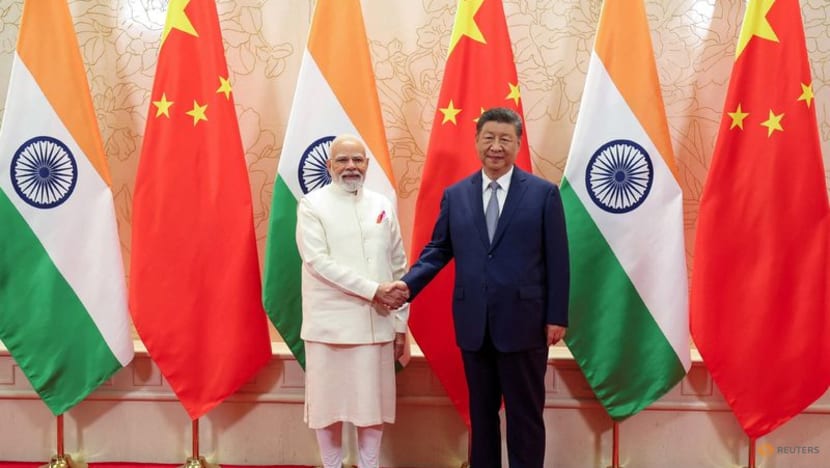Commentary: What resuming direct India-China flights reveals about Modi’s and Xi’s priorities
The decision to resume direct flights between India and China is partly economic, but geopolitics matters too, says an academic.

India's Prime Minister Narendra Modi shakes hands with Chinese President Xi Jinping during a meeting on the sidelines of the Shanghai Cooperation Organization (SCO) Summit in Tianjin, China, Aug 31, 2025. (Photo: India's Press Information Bureau/Handout via Reuters)
LONDON: No direct commercial flights have connected the world’s two most populous countries for the past five years, a consequence of COVID-19 shutdowns and then simmering tensions between India and China.
So, it was a surprise to many that one of the first announcements Indian Prime Minister Narendra Modi and China’s President Xi Jinping made at the Shanghai Cooperation Organization summit in Tianjin was about the resumption of direct commercial flights between the two nations.
The timing of this announcement is particularly noteworthy. The decision to resume flights is partly economic. Trade between India and China remains vast: Chinese firms continue to supply everything from machinery to consumer electronics, while Indian pharmaceutical and IT firms rely on predictable Chinese access.
Although direct flights halted in 2020, passenger traffic between the two countries did not disappear altogether. Data from OAG, an aviation analytics firm, illustrates this. In the past year alone, around 572,000 passengers travelled between India and China via hubs such as Singapore, Bangkok, and Hong Kong.
Although this figure pales in comparison with the 1.93 million passengers who used the same indirect routes at its peak in 2019, it still represents substantial demand today, and a serious potential for more. The ability to fly nonstop rather than routing through other intermediaries in Asia will unclog a channel of pent-up demand and lower travel time and costs.
GEOPOLITICS AT PLAY
But geopolitics matters here too. While shuttered borders from the early days of the pandemic offer an easy explanation for the halt in March 2020, the suspension in fact rested on an already brittle relationship between the two neighbours.
Years of recurring border clashes and seemingly never-ending standoffs had bedevilled relations. As recent as mid-2024, Beijing signalled its interest in restoring direct flights, but New Delhi held back, pointing to unresolved frontier disputes.
This reversal and sudden goodwill over the skies appears to have been accelerated by US President Donald Trump’s tariff hikes on Indian goods imported into the US just days before the Tianjin summit. The tariff rates, some of which have been doubled to as high as 50 per cent, are what Trump has called a “punishment” for India’s Russian oil imports.
China’s position is no less constrained, having been hit with some of the heaviest tariff hikes and left with a historically low allocation of US-China air route frequency allowances.
The reopening of the air corridor is arguably less about reconciliation between Delhi and Beijing than about diversification away from US-led multilateralism as well as alleviating pressure from Washington. In this light, it is telling that the reopening of air corridors between India and China was announced just weeks after Air India’s abrupt suspension of its own nonstop service from Delhi to Washington DC.
INDIA RELUCTANT TO RETURN TO PRE-PANDEMIC DYNAMICS
But while both leaders have lauded the return of economic activity and closer ties with the resumption of direct flights, Modi will be reluctant to return to the pre-pandemic dynamics of Chinese airline dominance and an over-reliance on Delhi-China routes.
Before the pandemic, Chinese state-owned carriers dominated the India-China market, operating between 72 to 80 per cent of the 539 direct services in December 2019. The imbalance was due to China’s larger and state-backed aviation market as well as India’s convoluted (though now repealed) “Five and 20” rule that forced Indian carriers to operate domestic routes for five years with 20 aircraft before being allowed to operate international routes.
Moreover, most India-China flights were focused primarily on travel between India’s capital Delhi and a range of major Chinese cities such as Beijing, Shanghai, Chengdu and Guangzhou. In fact, the last commercial flight between the two travelled from Delhi to Shanghai on Mar 20, 2020.
The Indian government has recently been on an airport construction boom, commissioning billion-dollar, starchitect-designed airports in Delhi, Mumbai, Bengaluru and elsewhere in anticipation of an aviation market boom in India. Modi will be keen to diversify routes beyond Delhi to spread the economic benefits of air connectivity more evenly across India’s regions and his supporters.
In addition to big business for its airlines, Beijing will also be eager to showcase and sell India its COMAC C919, a domestically manufactured passenger jet that represents Xi’s prestige project and decades of state-led investment. While the aircraft has been a centrepiece of recent air shows in Asia, it has yet to secure any foreign buyers. Selling the COMAC C919 to India would be a prestige coup and reinforce Xi Jinping’s narrative of technological self-sufficiency.
Modi, meanwhile, has spoken of an Asian-manufactured jet aircraft and ambitious plans for India’s national carrier, though such a purchase would not align with his government’s “Make in India” agenda. Regardless, selling the COMAC C919 will likely remain on Xi’s mind in his relationship with Modi over the next few years.
The return of direct flights between India and China should be seen less as an end, rather a means of managing a fraught relationship. For policymakers, the real question is whether this narrow reopening can become a foundation for broader, if still cautious, meaningful engagement between the two neighbours. But for travellers and businesses, the reopening of direct flights between India and China is most certainly welcome news.
Kazimier Lim is an MPhil/PhD scholar at the LSE Department of International Relations. This commentary first appeared on Lowy Institute’s The Interpreter.














